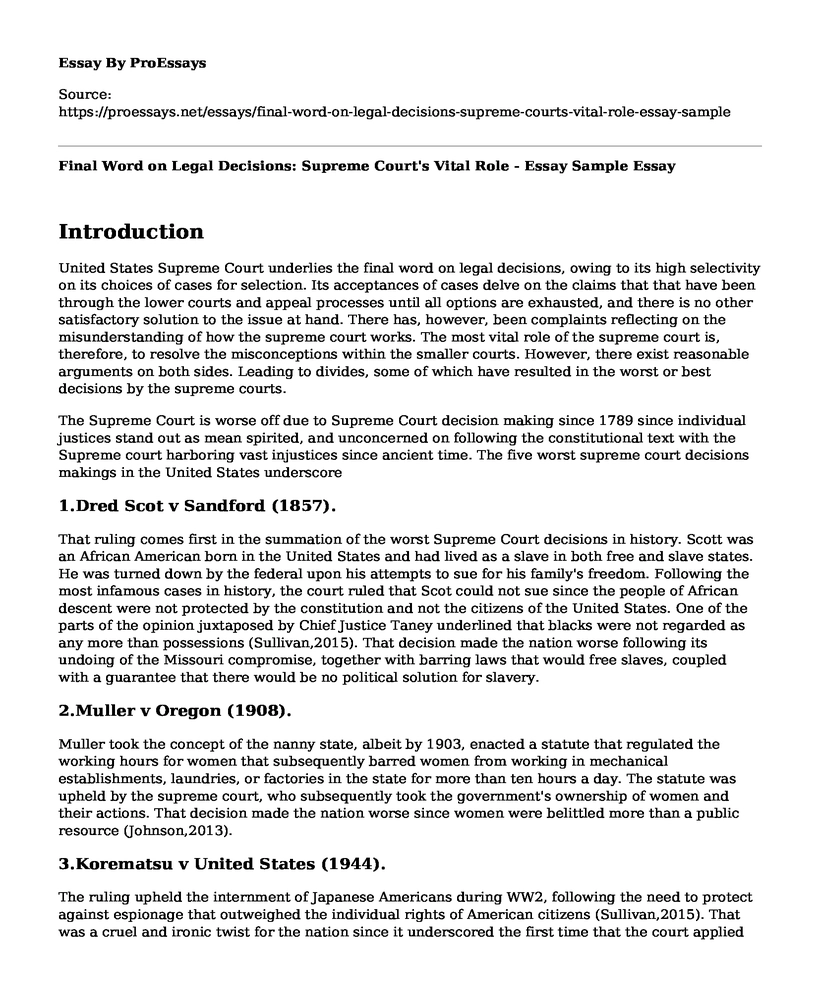Introduction
United States Supreme Court underlies the final word on legal decisions, owing to its high selectivity on its choices of cases for selection. Its acceptances of cases delve on the claims that that have been through the lower courts and appeal processes until all options are exhausted, and there is no other satisfactory solution to the issue at hand. There has, however, been complaints reflecting on the misunderstanding of how the supreme court works. The most vital role of the supreme court is, therefore, to resolve the misconceptions within the smaller courts. However, there exist reasonable arguments on both sides. Leading to divides, some of which have resulted in the worst or best decisions by the supreme courts.
The Supreme Court is worse off due to Supreme Court decision making since 1789 since individual justices stand out as mean spirited, and unconcerned on following the constitutional text with the Supreme court harboring vast injustices since ancient time. The five worst supreme court decisions makings in the United States underscore
1.Dred Scot v Sandford (1857).
That ruling comes first in the summation of the worst Supreme Court decisions in history. Scott was an African American born in the United States and had lived as a slave in both free and slave states. He was turned down by the federal upon his attempts to sue for his family's freedom. Following the most infamous cases in history, the court ruled that Scot could not sue since the people of African descent were not protected by the constitution and not the citizens of the United States. One of the parts of the opinion juxtaposed by Chief Justice Taney underlined that blacks were not regarded as any more than possessions (Sullivan,2015). That decision made the nation worse following its undoing of the Missouri compromise, together with barring laws that would free slaves, coupled with a guarantee that there would be no political solution for slavery.
2.Muller v Oregon (1908).
Muller took the concept of the nanny state, albeit by 1903, enacted a statute that regulated the working hours for women that subsequently barred women from working in mechanical establishments, laundries, or factories in the state for more than ten hours a day. The statute was upheld by the supreme court, who subsequently took the government's ownership of women and their actions. That decision made the nation worse since women were belittled more than a public resource (Johnson,2013).
3.Korematsu v United States (1944).
The ruling upheld the internment of Japanese Americans during WW2, following the need to protect against espionage that outweighed the individual rights of American citizens (Sullivan,2015). That was a cruel and ironic twist for the nation since it underscored the first time that the court applied strict scrutiny to racial discrimination that affected the US government.
4.Civil Rights Cases. (1883)
The court on a rule of 8-1 decisions held the provisions of the fourteenth thirteenth Amendment of not allowing Congress to prevent non-governmental and racial discrimination (Sullivan,2015). Those decisions affected the nation owing to its failure to protect civil rights, and worse still, it will take the country eighty years for the court to switch courses and allow the government to protect civil liberties.
5.Buck v Bell (1927)
The court upheld a terrible decision on an 8-1 ruling written by justice Oliver Wendel Holmes which underscored the forced sterilization of those with intellectual disabilities to protect the health of the state. Justice Holmes ruled that the state could prevent those who are manifestly unfit by continuing their kind, citing that three generations of imbeciles are enough (Sullivan,2015). That ruling affected the nation following its discriminative nature, and worse still, the ruling stills stands as good law.
Conclusion
Of all the decisions made by the US supreme court since 1789, the all-time worst decision was Dred Scot v Sanford which juxtaposed that African Americans could not be considered as American citizens/. It was the all-time worst decision since it not only bares the laws that could free slaves but also prevented any political solution to slavery. The all-time best solution by the US Supreme court decision underscored Loving v Virginia (1967), which underlined the restrictions of interracial marriages as unconstitutional. That resulted in the removal of racial discrimination in the realms of alliances between the whites and people of color
References
Johnson, D. (2013, March). Four Worst Supreme Court's Decisions of all Time. Mic. Retrievedfrom https://www.mic.com/articles/29205/4-worst-supreme-court-decisions-of-all-time
Sullivan, C. (2015, October).13 Worst Supreme Court Decisions of All Time. Find Law.Retrieved from https://blogs.findlaw.com/supreme_court/2015/10/13-worst-supremecourt decisions-of-all-time.html
Cite this page
Final Word on Legal Decisions: Supreme Court's Vital Role - Essay Sample. (2023, Jun 09). Retrieved from https://proessays.net/essays/final-word-on-legal-decisions-supreme-courts-vital-role-essay-sample
If you are the original author of this essay and no longer wish to have it published on the ProEssays website, please click below to request its removal:
- Paper Example on Types of Witnesses
- Essay Sample on John F Kennedys Murder
- Japan Tsunami 2011 Essay Example
- Paper Example on Stigmatization of Jail Victims: 5-Year Evaluation Study
- Essay Example on Two Revolutionary Lives: Martin & Malcolm Fight for Equality
- Essay Example on NYC: A Melting Pot for Immigrants: 4 Decades of Transformation
- Essay on Digital Forensics Certifications: Meeting Society's Demand for Cybercrime Prevention







